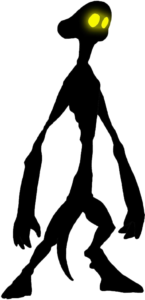
Every culture is scared of things that go bump in the night.
Modern civilization hasn’t quite desensitized us to our fear of the dark quite yet.
However, modern civilization’s fears of the supernatural are more than likely nothing compared to those of prehistoric humans.
Hidden deep in the Australian outback of Queensland lies a set of caves emboldened by paintings and engravings of one of the most mysterious figures in Aboriginal mythology, the Quinkan.
Quinkan or Quinkin are abstract figures that take a vaguely humanoid shape, although their forms are stretched and elongated to unnatural proportions.
The artwork of Quinkan is found primarily in the aptly named area of Queensland known as Quinkan Country.
The oldest artwork is estimated to be 15,000 to 30,000 years old, detailing different cultural practices, laws and Aboriginal spirituality.
The purpose of the Quinkan’s inclusion in these pieces of art, however, still remains a mystery.
These figures are prominently seen in artwork depicting gatherings of humans or animals, but precisely what they represent is still debated.
The most common explanation among archaeologists who have worked with the Australian Heritage Commission is that the term “Quinkan” is a bastardization of the phrase “guwin-gan” from the Aboriginal Kuku-Yalanji language.
Translated, “guwin-gan” represents the concept of a spirit that inhabits the Aboriginal plain of existence known as the Dreamtime or the Dreaming.
Essentially, under this notion, it is thought that the Quinkan were depictions of the spirits of Aboriginal peoples who passed away and were believed to be watching over their family.
Conversely, another interpretation of the idea that Quinkan equate to spirits is that the figures are spirits that only inhabit the Dreaming, being separate entities from humans entirely.

In the context of being individual spiritual entities, the Quinkan are postulated to be the embodiment of trickster spirits that interfere with humans.
The idea of being tricksters explains why the Quinkan are primarily depicted in situations with humans or interacting with nature, as they could have been a stand-in for the Aboriginal people’s explanation for various acts of nature.
One of the more popular theories among modern Australian citizens is that the Quinkan are depictions of the Yowie, the Aussie version of Bigfoot.
Aside from the Yowie, this creature goes by several different names such as the Yahoo, the Ghindaring, the Jurrawarra and the Thoolagal.
The Yowie is a figure passed down centuries through Aboriginal oral storytelling, resulting in the idea becoming conflated with the Quinkan.
The Yowie i very much a different entity than Bigfoot though, as descriptions of the creature vary greatly.
Said to stand at least 12 feet tall, the Yowie towers over at the America Bigfoot which usually ranges from 6 to 8 feet tall.
Gunedah Aboriginal stories tell tales in which the Aboriginal peoples and tribes of Quinkan or Yowies lived in conflict as the original inhabitants of the Australian continent.
The stories usually focused on the Gunedah and other Aboriginal groups fending off the thieving Quinkan tribes and living in perpetual conflict as the Quinkan were fast enough to run away from the defenders if they gave chase.
As European colonization began to ravage Australia, forcing Aboriginal groups into their own sections of the country, written reports of Yowie sightings from Europeans began to pop up.
The earliest written sightings of the Yowie started appearing in the early 1700s, but accounts became popularized in the mid-1870s when sighting stories were published in the “Australian Town and Country Journal.”
While there may not be a definitive explanation to what the Quinkan represent, it is certainly clear that the mysterious creatures are an important part of Aboriginal mythology and culture.
We may never get an exact answer to the Quinkan’s origins, but at the very least we can remain fascinated by the relics left behind by prehistoric humans and try our best to preserve the legacy and mystery of the Aboriginal Dreamtime.

